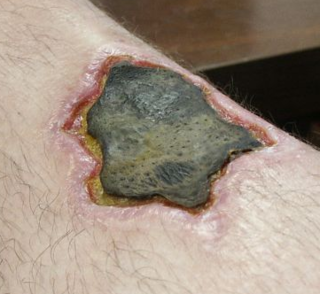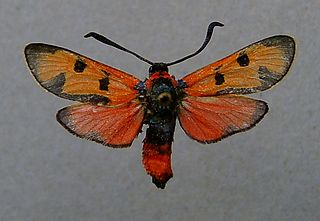
The bowl and doily spider is a species of sheet weaver found in North and Central America. It is a small spider, about 4 mm (0.16 in) long, that weaves a fairly complex and unique sheet web system consisting of an inverted dome shaped web, or "bowl," suspended above a horizontal sheet web, or "doily", hence its common name. The spider hangs from the underside of the "bowl", and bites through the web small flies, gnats and other small insects that fall down into the non-sticky webbing. The webs are commonly seen in weedy fields and in shrubs, and may often contain both a male and a female spider in late summer - like many linyphiids, Frontinella males and females may cohabitate for some time. Males exhibit competition for female mates both by fighting and sperm competition. Uniquely, these spiders exhibit behavioral thermoregulation and have lengthened circadian rhythms.

Loxoscelism is a condition occasionally produced by the bite of the recluse spiders. The area becomes dusky and a shallow open sore forms as the skin around the bite dies (necrosis). It is the only proven type of necrotic arachnidism in humans. While there is no known therapy effective for loxoscelism, there has been research on antibiotics, surgical timing, hyperbaric oxygen, potential antivenoms and vaccines. Because of the number of diseases that may mimic loxoscelism, it is frequently misdiagnosed by physicians.

Senegalia laeta, the gay acacia or daga, is a legume found in the family Fabaceae. It was formerly included in the genus Acacia.
Patrick Lussier is a Canadian-American filmmaker and editor, known for his numerous collaborations with director Wes Craven and fellow screenwriters Laeta Kalogridis and Todd Farmer, as well as his work in the horror genre.

Willis's antbird, also known as the laeta antbird, is a species of bird in the family Thamnophilidae. It is endemic to Brazil. It was formerly considered a subspecies of dusky antbird.
The buff-bridled Inca finch is a species of bird traditionally placed in the family Emberizidae, but it may be more closely related to the Thraupidae.
The ribbed elimia, scientific name †Elimia laeta, was a species of freshwater snail with an operculum, aquatic gastropod mollusks in the family Pleuroceridae. This species was endemic to the United States. It is now extinct.
Laeta was the second Empress consort of Gratian of the Western Roman Empire.

Anna Hutchison is a New Zealand actress. Her roles include Delphi Greenlaw on Shortland Street (2002–04); Lily Chilman, the Yellow Cheetah Ranger on Power Rangers Jungle Fury (2008); Allison Dine on Underbelly: A Tale of Two Cities (2009); Amy Smart on Go Girls (2009–12); Jules Louden in The Cabin in the Woods (2012); Laeta on Spartacus: War of the Damned (2013); Sasha on Anger Management (2013–14) and Kim in The Right Girl (2015).
Laeta Kalogridis is an American screenwriter and television and film producer of Greek descent. She has written scripts for Alexander (2004), Night Watch (2004), Pathfinder (2007) and Shutter Island (2010). She also served as an executive producer for the television series Birds of Prey and Bionic Woman, and she co-wrote the screenplay for Terminator Genisys (2015) and Alita: Battle Angel (2019). She is the creator and executive producer of the Netflix series Altered Carbon (2018).

Zygaena laeta, the bloodword burnet, is a moth of the family Zygaenidae. It is found in Central and South-Eastern Europe.In Z. laeta the collar and patagia as well as the apical half of the abdomen are red: also the wings are testaceous red except some black spots on the forewing. Larva of light bluish green, with while dorsal and lateral lines, along which there are blackdots. Pupa yellow, anteriorly dark brown, in a whitish cocoon. The wingspan is 26–34 mm.
Capsula laeta, the red sedge borer, is a moth of the family Noctuidae. The species was first described by Herbert Knowles Morrison in 1875. It is found in North America, including Ohio, Illinois, New Jersey and Ontario.
Chersotis laeta is a moth of the family Noctuidae. It is found in number of isolated populations from Greece to the Caucasus, Turkey, Lebanon, Israel and Syria.
F. communis may refer to:

Frontinella is a genus of dwarf spiders that was first described by Frederick Octavius Pickard-Cambridge in 1902.

Russula laeta is a brittle gill species that was first described by Julius Schäffer in 1952. This species is critically endangered in Belgium.
Erora laeta, the early hairstreak, is a butterfly of the family Lycaenidae. It is found in eastern Canada and the United States. The habitat consists of deciduous and mixed woods.
Frontinella huachuca is a species of sheetweb spider in the family Linyphiidae. It is found in the United States and Mexico.
Raynick Laeta is a Solomon Islands footballer who plays as a forward for the Henderson Eels.






